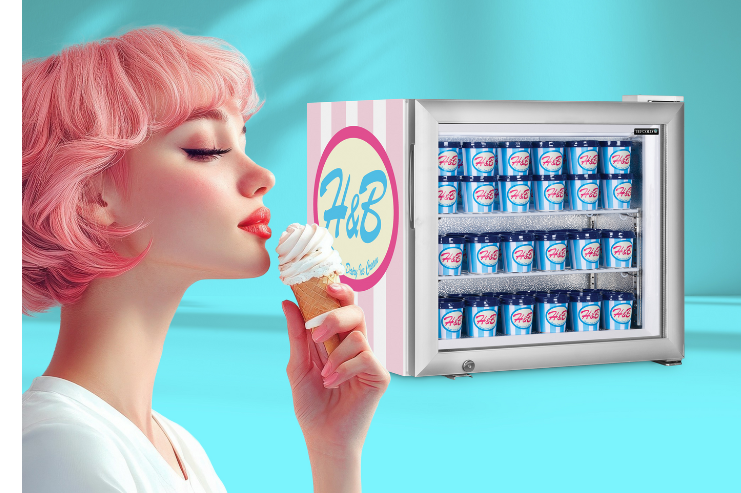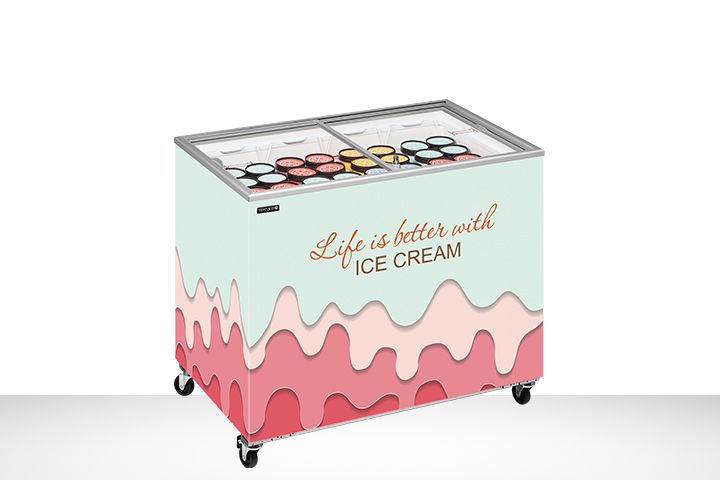What’s the ideal temperature for storing ice cream?
We’ve put this post together to explain why temperature control – and the right ice cream freezer – are so crucial for your business’s ongoing success.
22 April 2025

We’ve put this post together to explain why temperature control – and the right ice cream freezer – are so crucial for your business’s ongoing success.
Ice cream is delicate. If the temperature is even a couple of degrees off, it’s ruined. You’ll notice immediate problems like an odd taste, texture loss, freezer burn or, most dramatic of all, a melted puddle of creamy mess in the bottom of the freezer.
Whether you’re running a small ice cream shop or a large-scale operation, effective temperature management underpins all ice cream businesses. That’s why we’ve put this blog together to explain why temperature control – and the right ice cream freezer – are so crucial for your ongoing success.

Ice cream’s ‘sweet spot’ temperature
You should keep your ice cream between -18 °C and -24 °C. At this temperature, your product should stay firm, smooth and deliciously creamy.
Any higher than -18 or lower than -24, and you’ll start to run into problems. If the temperature rises above -18, ice crystals can form on the ice cream, leading to a strange texture. If the temperature gets high enough that it starts to thaw, you’ll have to throw it away. On the other hand, if the temperature drops too low, your ice cream will start to suffer from freezer burn and become harder to scoop.
So, keep your ice cream freezer between -18 °C and -24 °C to maintain that sweet spot. And remember that different types of ice cream (such as gelato or sorbet) require slightly different temperature ranges, which is why they’re usually kept in separate freezers. The ideal temperature range for sorbet is between -18 °C and -20 °C, while a gelato should be slightly warmer, between -14 °C and -18 °C.
Why temperature fluctuations damage ice cream
After hungry toddlers and direct sunshine, temperature fluctuation is ice cream’s worst enemy. Every time your freezer’s temperature goes too high, ice crystals form and melt, then reform. After this happens, even once, your ice cream’s smooth texture is destroyed. The result is a grainy, unpleasant sensation and taste for your customers. Of course, the more temperature fluctuations your ice cream experiences, the worse the problem becomes. This can lead to wastage, or you may experience reputational damage.
There are all sorts of potential reasons for temperature fluctuations, including:
• Old freezer unit with poor performance (compressors, seals, fans etc)
• Poor ice cream freezer maintenance
• Ice cream is left out at room temperature for too long
• The freezer door is left open or ajar
• Extended power cuts
Doing everything you can to ensure your ice cream doesn’t go through temperature fluctuations is a worthwhile investment.

Practical ice cream temperature control for businesses
Maintaining the right temperature in your ice cream freezers is sometimes easier said than done. But it doesn’t have to be a constant challenge. First, you need the right equipment. High-quality, modern commercial ice cream freezers come with advanced built-in thermostats and temperature management systems. In contrast, older freezers might not work as well and are more susceptible to failure.
Controlling ice cream temperatures in retail environments can be tricky, especially when the freezers are in the customer area. During busy times, freezer doors open more frequently, and customers might accidentally leave them open or take longer than expected to decide what to buy.
And yet, retail spaces are where ice cream sales thrive, so there are ways to manage these challenges. You could place friendly signage encouraging customers to close the freezer doors. Other solutions include upgrading seals, scheduling regular maintenance or investing in newer freezers with sturdy self-closing doors.
Why ice cream freezer temperature matters for your business
Cement your reputation as the seller of the highest quality ice cream in your region. The most critical step is a modern commercial ice cream freezer. Let your brand reputation and word of mouth do the marketing for you and get ready to drive your sales when the sun comes out.
Plus, poor ice cream management leads to unwanted waste, which further affects your bottom line.
Let us help you make sure your business has the right equipment on hand. With over three decades of experience, our industry-leading commercial ice cream freezer range is sure to have something that meets your business’s needs. Don’t let your ice cream business melt under pressure. Let us help keep your ice cream cool, your customer flow secure and your business rich and smooth.
Please note: This article is designed as a guide but depending on your environment, the type of ice cream freezer you purchase and the selection of frozen treats you’re selling the ideal temperature may vary. If you’re a customer or looking to purchase from us and would like some support, please get in touch with our team.
